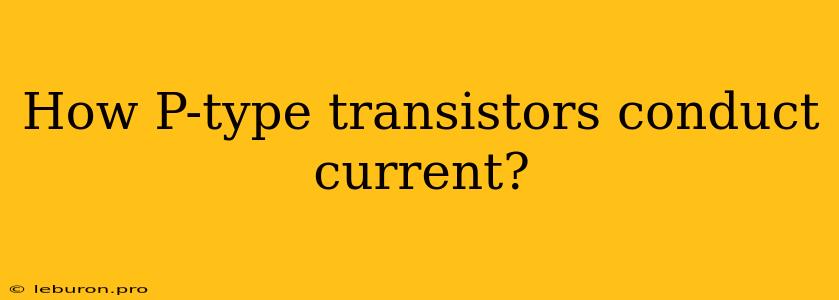How P-type Transistors Conduct Current: A Detailed Explanation
Transistors, the building blocks of modern electronics, are semiconductor devices that control the flow of electrical current. They come in two primary types: N-type and P-type. While N-type transistors rely on the movement of electrons for conduction, P-type transistors utilize "holes" - the absence of electrons - for current flow. This seemingly counterintuitive concept might seem confusing at first, but understanding how holes behave in a P-type transistor is crucial for grasping the fundamental principles of semiconductor electronics.
The Concept of Holes
Imagine a crystal lattice of silicon atoms, the most common material used in transistors. Each silicon atom has four valence electrons, forming covalent bonds with its neighbors. In a perfect crystal, all valence electrons are tied up in these bonds, leaving no free electrons for conduction. However, introducing impurities into this crystal lattice can alter its electrical properties.
P-type doping: In the case of P-type transistors, impurities like Boron, Aluminum, or Gallium are added to the silicon. These impurities have three valence electrons each. When they replace a silicon atom in the lattice, they create a "hole" - a vacant space where an electron would normally be. These holes behave as if they are positively charged particles, even though they are simply the absence of electrons.
Conduction in P-type transistors
Now, let's understand how these holes facilitate current flow in a P-type transistor.
- Thermal Excitation: At room temperature, some electrons gain enough energy to break free from their covalent bonds and move around the crystal lattice. This leaves behind a hole.
- Hole Movement: When an electron from a nearby bond moves into the hole, it essentially fills it up. But this creates a new hole at the previous location. The hole seems to have "moved" to a new position.
- Drift Current: An external electric field can influence the movement of holes. If a positive voltage is applied to one end of the P-type material, the holes, being positively charged, will drift towards the positive terminal, creating a current.
Important Note: It's crucial to remember that holes are not real particles. They are merely a way to visualize the absence of an electron. The actual conduction occurs due to the movement of electrons within the crystal lattice, filling the empty spaces left behind. However, it's easier to conceptualize this movement as the flow of positively charged "holes."
The P-type Transistor Structure
Now, let's delve into the structure of a typical P-type transistor. It consists of three regions:
- Emitter: Heavily doped P-type region where holes are generated.
- Base: Lightly doped N-type region.
- Collector: Heavily doped P-type region where holes are collected.
How the P-type transistor works:
- Base-Emitter Junction: When a positive voltage is applied to the emitter with respect to the base, holes from the emitter flow into the base. This creates a "forward bias" in the base-emitter junction.
- Base-Collector Junction: The base is thin and lightly doped, allowing most of the holes to pass through it.
- Collector Current: These holes are then collected by the collector, which is held at a higher positive voltage compared to the base. This creates a "reverse bias" in the base-collector junction, preventing electrons from the collector from entering the base.
- Amplification: By controlling the number of holes injected from the emitter into the base, we can control the amount of current flowing through the collector, achieving the amplification effect for which transistors are known.
Advantages of P-type transistors
- Higher Current Carrying Capacity: P-type transistors have higher current carrying capabilities compared to N-type transistors, particularly at high frequencies.
- Lower Noise: They generally exhibit lower noise levels.
- Wide Applications: They are used in various applications, including amplifiers, switches, and logic circuits.
Conclusion
Understanding how P-type transistors conduct current is essential for anyone working with semiconductor devices. While the concept of holes might seem abstract at first, it provides a clear picture of how these devices function and contribute to the complex world of electronics. The movement of "holes" in P-type transistors is a fascinating example of how the absence of something can be used to control the flow of electricity. As technology advances, understanding these fundamental concepts will become even more crucial in developing new and innovative electronic systems.
